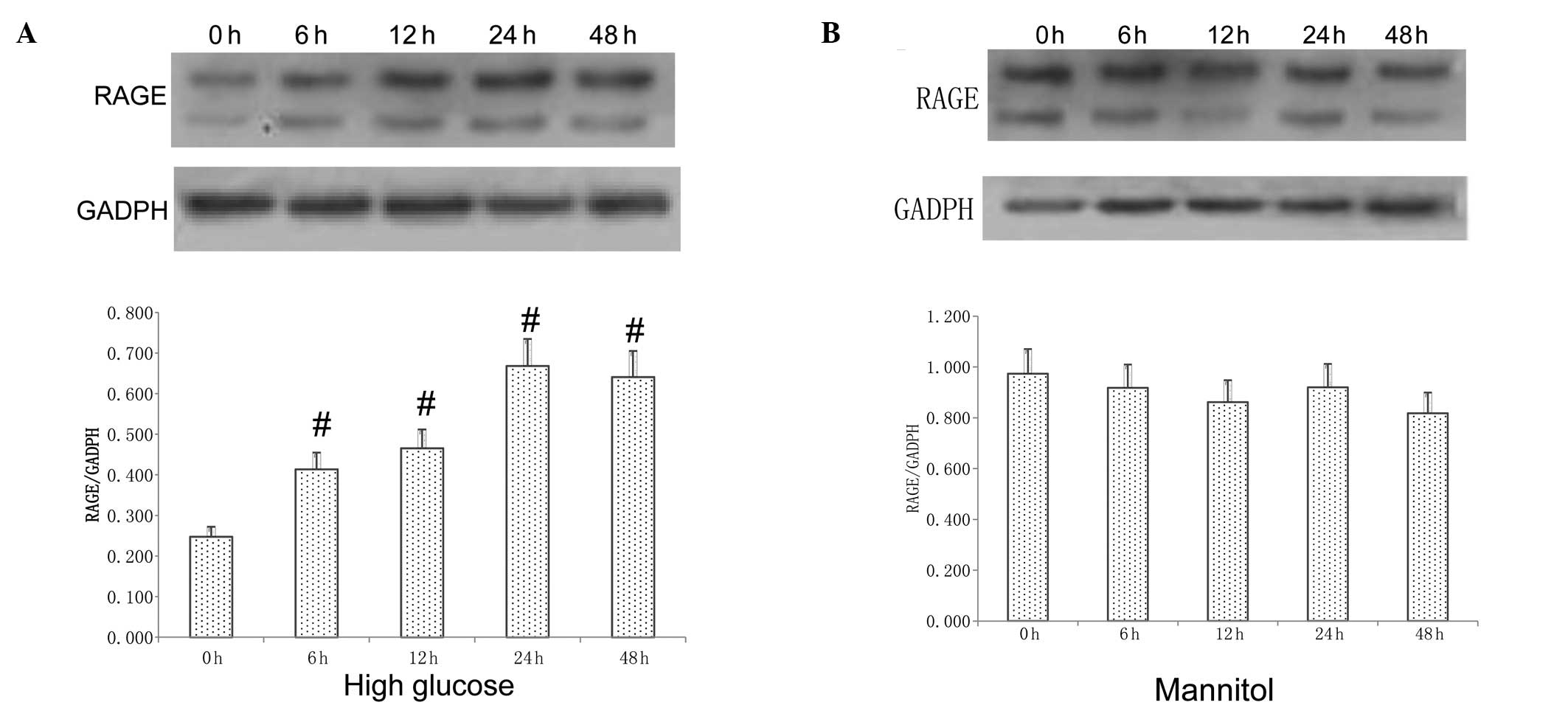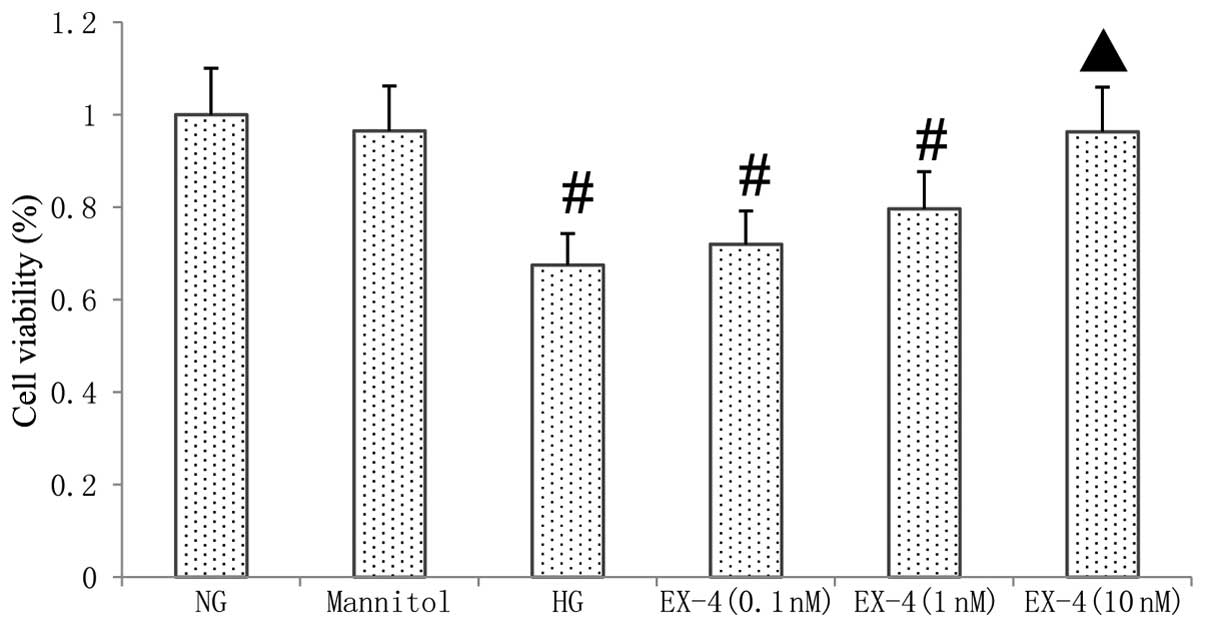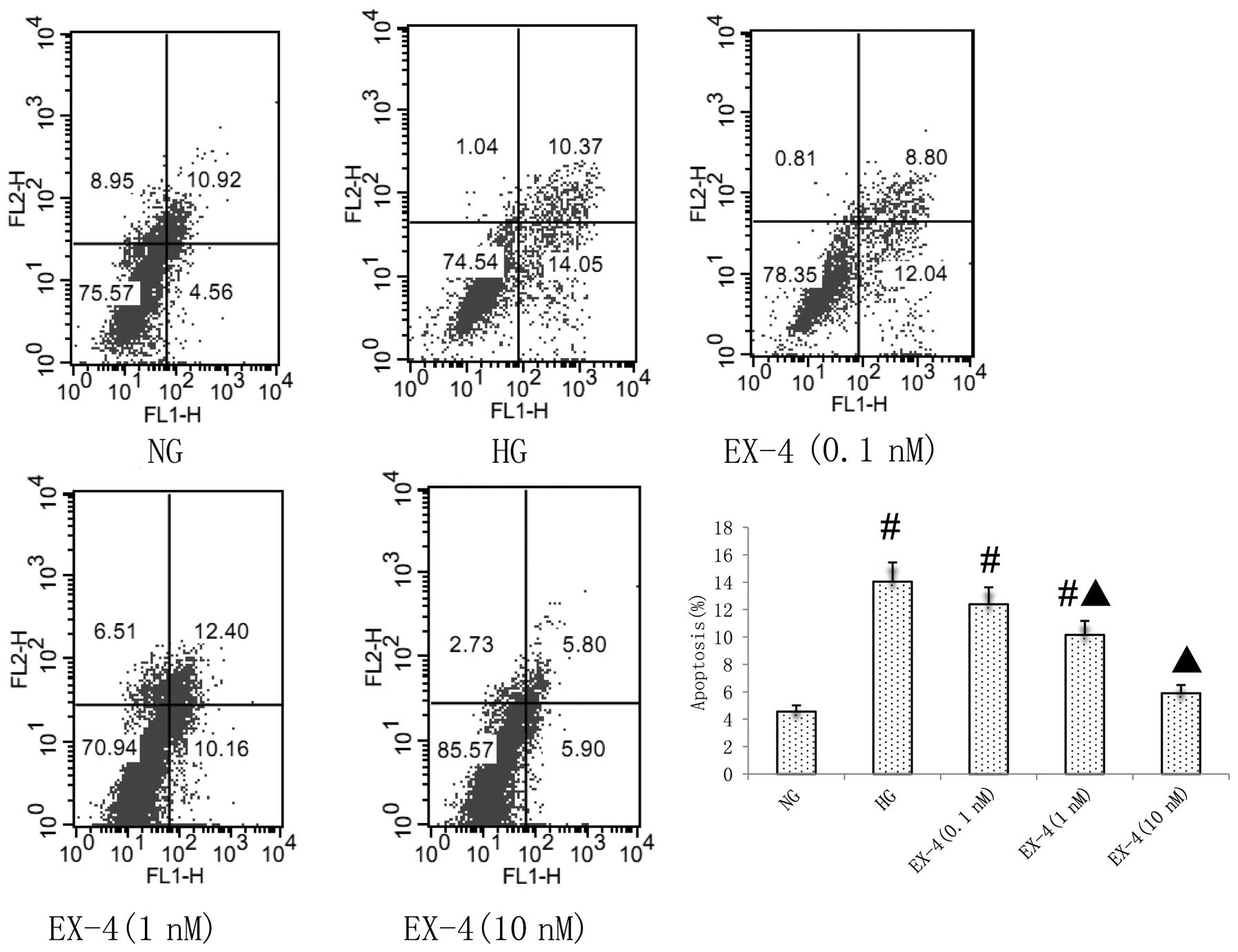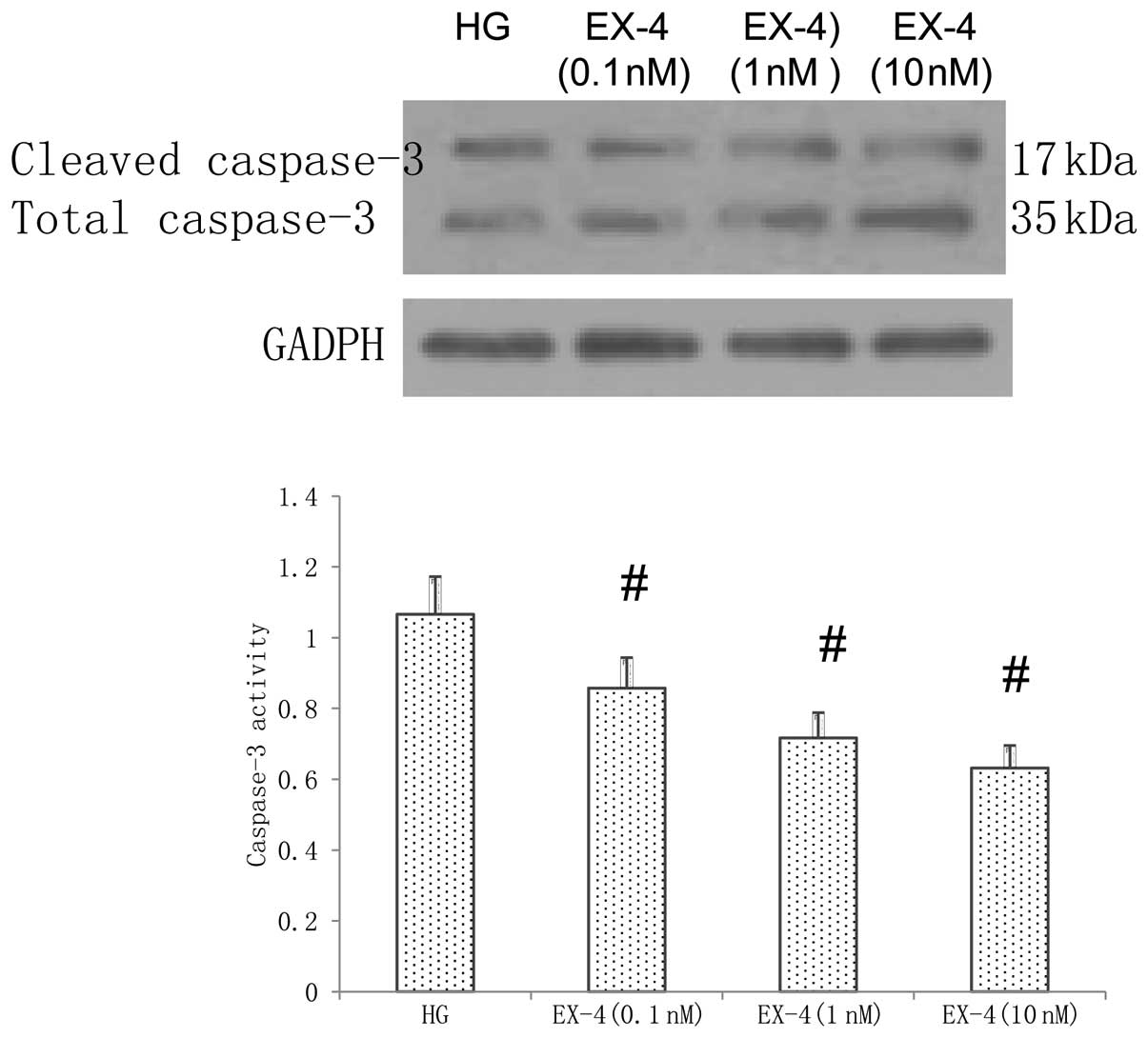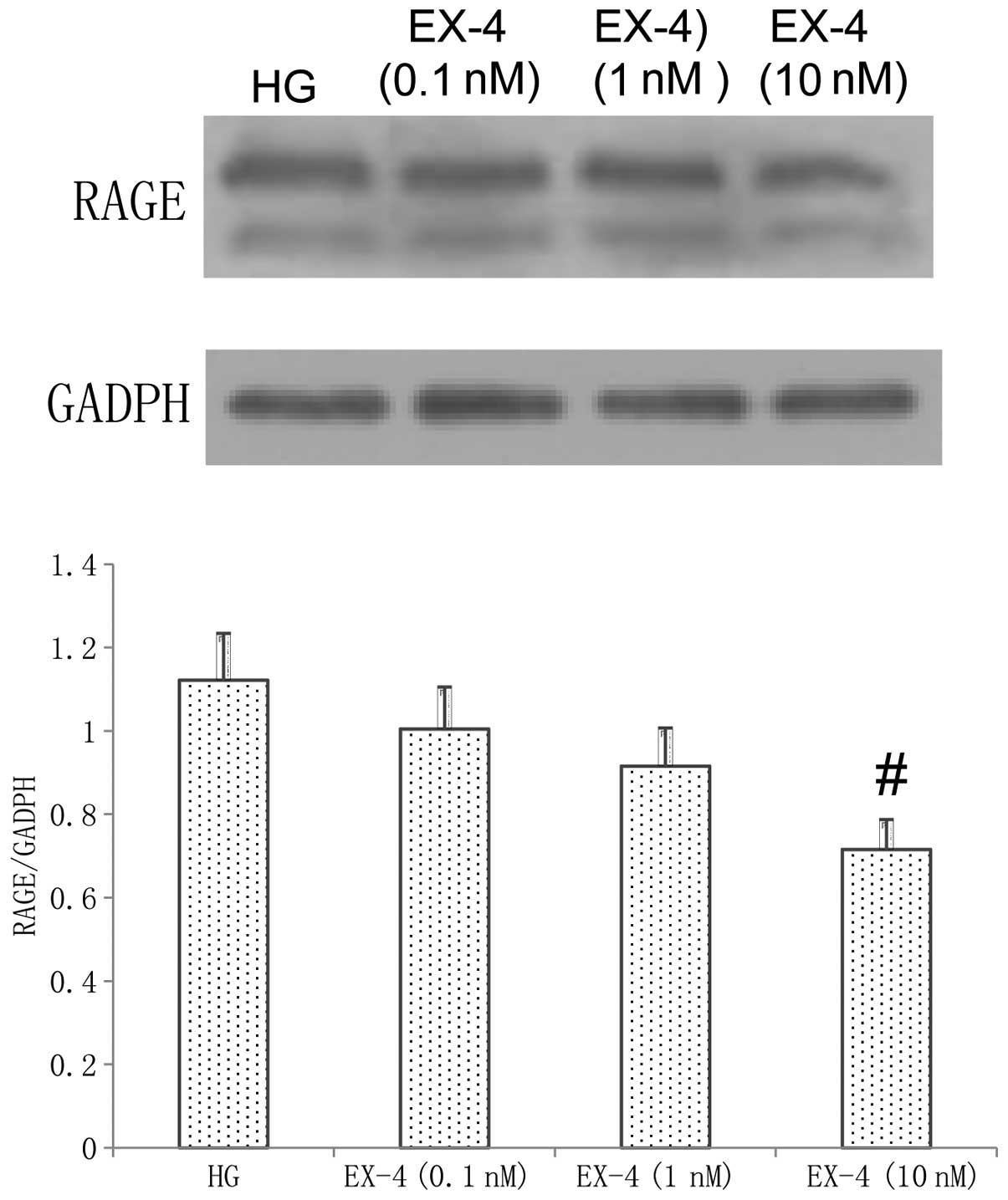|
1
|
Cai L, Li W, Wang G, Guo L, Jiang Y and
Kang YJ: Hyperglycemia-induced apoptosis in mouse myocardium:
mitochondrial cytochrome c-mediated caspase-3 activation
pathway. Diabetes. 51:1938–1948. 2002. View Article : Google Scholar : PubMed/NCBI
|
|
2
|
Li Z, Zhang T, Dai H, et al: Involvement
of endoplasmic reticulum stress in myocardial apoptosis of
streptozocin-induced diabetic rats. J Clin Biochem Nutr. 41:58–67.
2007. View Article : Google Scholar : PubMed/NCBI
|
|
3
|
Kuethe F, Sigusch HH, Bornstein SR, Hilbig
K, Kamvissi V and Figulla HR: Apoptosis in patients with dilated
cardiomyopathy and diabetes: a feature of diabetic cardiomyopathy?
Horm Metab Res. 39:672–676. 2007. View Article : Google Scholar : PubMed/NCBI
|
|
4
|
Yu XY, Song YH, Geng YJ, et al: Glucose
induces apoptosis of cardiomyocytes via microRNA-1 and IGF-1.
Biochem Biophys Res Commun. 376:548–552. 2008. View Article : Google Scholar : PubMed/NCBI
|
|
5
|
Liang JL, Xiao DZ, Liu XY, et al: High
glucose induces apoptosis in AC16 human cardiomyocytes via
macrophage migration inhibitory factor and c-Jun N-terminal kinase.
Clin Exp Pharmacol Physiol. 37:969–973. 2010. View Article : Google Scholar : PubMed/NCBI
|
|
6
|
Fiordaliso F, Bianchi R, Staszewsky L, et
al: Antioxidant treatment attenuates hyperglycemia-induced
cardiomyocyte death in rats. J Mol Cell Cardiol. 37:959–968. 2004.
View Article : Google Scholar : PubMed/NCBI
|
|
7
|
Neeper M, Schmidt AM, Brett J, et al:
Cloning and expression of a cell surface receptor for advanced
glycosylation end products of proteins. J Biol Chem.
267:14998–15004. 1992.PubMed/NCBI
|
|
8
|
Yan SF, Ramasamy R and Schmidt AM:
Receptor for AGE (RAGE) and its ligands - cast into leading roles
in diabetes and the inflammatory response. J Mol Med (Berl).
87:235–247. 2009. View Article : Google Scholar : PubMed/NCBI
|
|
9
|
Yao D and Brownlee M:
Hyperglycemia-induced reactive oxygen species increase expression
of the receptor for advanced glycation end products (RAGE) and RAGE
ligands. Diabetes. 59:249–255. 2010. View Article : Google Scholar : PubMed/NCBI
|
|
10
|
Zong H, Ward M, Madden A, et al:
Hyperglycaemia-induced pro-inflammatory responses by retinal Müller
glia are regulated by the receptor for advanced glycation
end-products (RAGE). Diabetologia. 53:2656–2666. 2010.PubMed/NCBI
|
|
11
|
Bucciarelli LG, Ananthakrishnan R, Hwang
YC, et al: RAGE and modulation of ischemic injury in the diabetic
myocardium. Diabetes. 57:1941–1951. 2008. View Article : Google Scholar : PubMed/NCBI
|
|
12
|
Mannucci E and Rotella CM: Future
perspectives on glucagon-like peptide-1, diabetes and
cardiovascular risk. Nutr Metab Cardiovasc Dis. 18:639–645. 2008.
View Article : Google Scholar : PubMed/NCBI
|
|
13
|
Hiki M, Shimada K, Kiyanagi T, et al:
Single administration of alpha-glucosidase inhibitors on
endothelial function and incretin secretion in diabetic patients
with coronary artery disease - Juntendo University trial: effects
of miglitol on endothelial vascular reactivity in type 2 diabetic
patients with coronary heart disease (J-MACH). Circ J.
74:1471–1478. 2010.
|
|
14
|
Nikolaidis LA, Mankad S, Sokos GG, et al:
Effects of glucagon-like peptide-1 in patients with acute
myocardial infarction and left ventricular dysfunction after
successful reperfusion. Circulation. 109:962–965. 2004. View Article : Google Scholar : PubMed/NCBI
|
|
15
|
Sokos GG, Nikolaidis LA, Mankad S, Elahi D
and Shannon RP: Glucagon-like peptide-1 infusion improves left
ventricular ejection fraction and functional status in patients
with chronic heart failure. J Card Fail. 12:694–699. 2006.
View Article : Google Scholar : PubMed/NCBI
|
|
16
|
Halbirk M, Nørrelund H, Møller N, et al:
Cardiovascular and metabolic effects of 48-h glucagon-like
peptide-1 infusion in compensated chronic patients with heart
failure. Am J Physiol Heart Circ Physiol. 298:H1096–H1102. 2010.
View Article : Google Scholar : PubMed/NCBI
|
|
17
|
Brown SB, Libonati JR, Selak MA, Shannon
RP and Simmons RA: Neonatal exendin-4 leads to protection from
reperfusion injury and reduced rates of oxidative phosphorylation
in the adult rat heart. Cardiovasc Drugs Ther. 24:197–205. 2010.
View Article : Google Scholar : PubMed/NCBI
|
|
18
|
Sonne DP, Engstrøm T and Treiman M:
Protective effects of GLP-1 analogues exendin-4 and GLP-1(9–36)
amide against ischemia-reperfusion injury in rat heart. Regul Pept.
146:243–249. 2008.PubMed/NCBI
|
|
19
|
Barakat GM, Nuwayri-Salti N, Kadi LN,
Bitar KM, Al-Jaroudi WA and Bikhazi AB: Role of glucagon-like
peptide-1 and its agonists on early prevention of cardiac
remodeling in type 1 diabetic rat hearts. Gen Physiol Biophys.
30:34–44. 2011. View Article : Google Scholar : PubMed/NCBI
|
|
20
|
Hu X, Zhou X, He B, et al: Minocycline
protects against myocardial ischemia and reperfusion injury by
inhibiting high mobility group box 1 protein in rats. Eur J
Pharmacol. 638:84–89. 2010. View Article : Google Scholar : PubMed/NCBI
|
|
21
|
Anderson EJ, Rodriguez E, Anderson CA,
Thayne K, Chitwood WR and Kypson AP: Increased propensity for cell
death in diabetic human heart is mediated by
mitochondrial-dependent pathways. Am J Physiol Heart Circ Physiol.
300:H118–H124. 2011. View Article : Google Scholar : PubMed/NCBI
|
|
22
|
Kim SW, Lim CM, Kim JB, et al:
Extracellular HMGB1 released by NMDA treatment confers neuronal
apoptosis via RAGE-p38 MAPK/ERK signaling pathway. Neurotox Res.
20:159–169. 2011. View Article : Google Scholar : PubMed/NCBI
|
|
23
|
Zhu Y, Shu T, Lin Y, et al: Inhibition of
the receptor for advanced glycation endproducts (RAGE) protects
pancreatic β-cells. Biochem Biophys Res Commun. 404:159–165.
2011.PubMed/NCBI
|
|
24
|
Jin Q, Chen H, Luo A, Ding F and Liu Z:
S100A14 stimulates cell proliferation and induces cell apoptosis at
different concentrations via receptor for advanced glycation end
products (RAGE). PLoS One. 6:e193752011. View Article : Google Scholar : PubMed/NCBI
|
|
25
|
Davidson MH: Cardiovascular effects of
glucagonlike peptide-1 agonists. Am J Cardiol. 108:33B–41B. 2011.
View Article : Google Scholar : PubMed/NCBI
|
|
26
|
Ravassa S, Zudaire A, Carr RD and Díez J:
Antiapoptotic effects of GLP-1 in murine HL-1 cardiomyocytes. Am J
Physiol Heart Circ Physiol. 300:H1361–H1372. 2011. View Article : Google Scholar : PubMed/NCBI
|
|
27
|
Chen TH, Wo HT, Wu CC, et al: Exendin-4
attenuates lipopolysaccharides induced inflammatory response but
does not protects H9c2 cells from apoptosis. Immunopharmacol
Immunotoxicol. 34:484–490. 2012. View Article : Google Scholar : PubMed/NCBI
|
|
28
|
Ishibashi Y, Nishino Y, Matsui T, Takeuchi
M and Yamagishi S: Glucagon-like peptide-1 suppresses advanced
glycation end product-induced monocyte chemoattractant protein-1
expression in mesangial cells by reducing advanced glycation end
product receptor level. Metabolism. 60:1271–1277. 2011. View Article : Google Scholar
|
|
29
|
Ishibashi Y, Matsui T, Takeuchi M and
Yamagishi S: Glucagon-like peptide-1 (GLP-1) inhibits advanced
glycation end product (AGE)-induced up-regulation of VCAM-1 mRNA
levels in endothelial cells by suppressing AGE receptor (RAGE)
expression. Biochem Biophys Res Commun. 391:1405–1408. 2010.
View Article : Google Scholar : PubMed/NCBI
|















